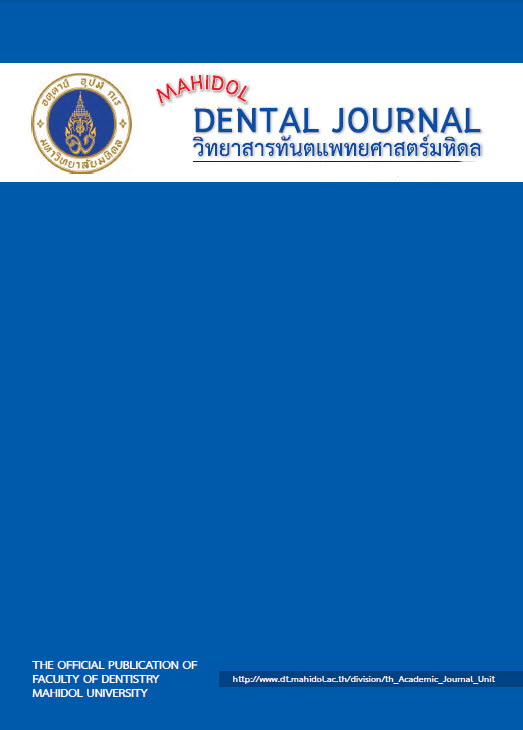Scanning electron microscopic characterization of dental calculus in human teeth
Main Article Content
Abstract
Objectives: The purpose of this study was to examine the surface changes of dental calculus in human teeth by scanning electron microscope.
Materials and methods: Fifteen human maxillary permanent molar teeth and fifteen mandibular incisor teeth with dental calculus from 30 patients requiring tooth extraction, one tooth from each patient, were used in this study. The specimens were collected from private dental clinics and hospitals in Bangkok and other provinces. After extractions, all teeth were stored in 10% formalin until required. After the teeth were rinsed under running tap water, each tooth was then sectioned using Micro Cutting Instrument, Isomet Low-speed Saw, Buehler, Illinois, USA. Small blocks of the areas of the teeth with dental calculi were removed from the selected areas using a water-cooled bur in a dental handpiece. Each block was immersed in a 5.25% sodium hypochlorite solution for 24 h at room temperature to remove soft tissue or organic substances and then rinsed thoroughly in distilled water, and then dehydrated in a series of graded ethyl alcohol (2 changes, 15 min each): 50%, 60%, 70%, 80%, 95%, 100% and dried by leaving the specimens at room temperature for 24 hours. After drying, the specimens were mounted on aluminum stubs, coated with gold, thickness of 100-300 Å, with an ion sputter coater, and viewed with a JEOL JSM-6610LV scanning electron microscope, Japan at six magnifications: X20, X200, X1,000, X2,000, X10,000 and X20,000. The photomicrographs were described. Representative electron micrographs were selected for presentation in this paper.
Results: At low magnifications, the surface characteristics of the dental calculi in human teeth appeared pitted with some bacilli and cocci on the surfaces. At high magnifications, calcified bacteria were found. Globular crystals were deposited in between the pits. These crystals were deposited to become larger calcified masses which were irregularly shaped. There were various forms of crystal growths: needle-like or elongated, cuboidal, and different shapes and sizes of platelet forms.
Conclusions: By scanning electron microscopic study, the surface characteristics of the dental calculi deposited on the human maxillary permanent molar teeth and mandibular incisor teeth are the same.
Article Details
References
2. Jepsen S, Deschner J, Braun A, Schwarz F, Eberhard J. Calculus removal and the prevention of its formation. Periodontol 2000 2011; 55: 167-88.
3. สำนักทันตสาธารณสุข กรมอนามัย กระทรวงสาธารณสุข. รายงานผลการสำรวจสภาวะสุขภาพช่องปากระดับประเทศ ครั้งที่ 7 ประเทศไทย พ.ศ. 2555. พิมพ์ครั้งที่ 1. กรุงเทพฯ: สำนักงานกิจการโรงพิมพ์องค์การสงเคราะห์ทหารผ่านศึก; 2556.
4. Mealey BL. Periodontal disease and diabetes. A two-way street. JADA 2006; 137: 26s-31s.
5. Seshima F, Nishina M, Namba T, Saito A. Periodontal regenerative therapy in patient with chronic periodontitis and type 2 diabetes mellitus: A case report. Bull Tokyo Dent Coll 2016; 57: 97-104.
6. Stewart R, West M. Increasing evidence for an association between periodontitis and cardiovascular disease. Circulation 2016; 133: 549-51.
7. Mesa F, Pozo E, O’Valle F, Puertas A, Magan-Fernandez A, Rosel E, Bravo M. Relationship between periodontal parameters and plasma cytokine profiles in pregnant woman with preterm birth or low birth weight. Clin Oral Investig 2016; 20: 669-74.
8. Jones SJ. Morphology of calculus formation on the human tooth surface. Proc Roy Soc Med 1972; 65: 903-5.
9. Lustmann J, Lewin-Epstein J, Shteyer A. Scanning electron microscopy of dental calculus. Calcif Tiss Res 1976; 21: 47-55.
10. Kodaka T, Ohara Y. Scanning electron microscopic observations of epitaxial growth-like crystals in human early and old dental calculi. J Showa Univ Dent Soc 1994; 14: 116-9.
11. Rohanizadeh R, Leqeros RZ. Ultrastructural study of calculus-enamel and calculus-root interfaces. Arch Oral Biol 2005; 50: 89-96.


